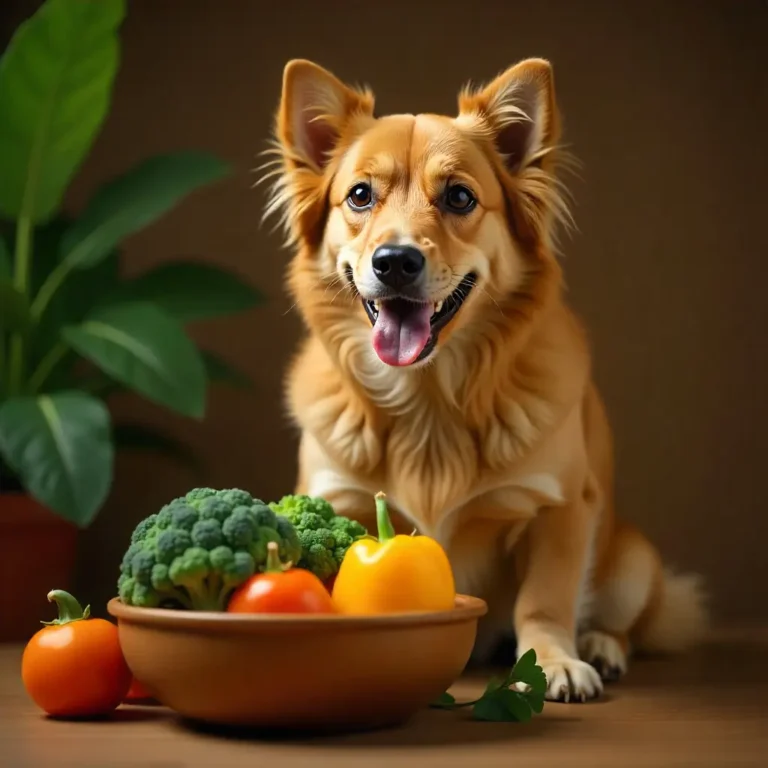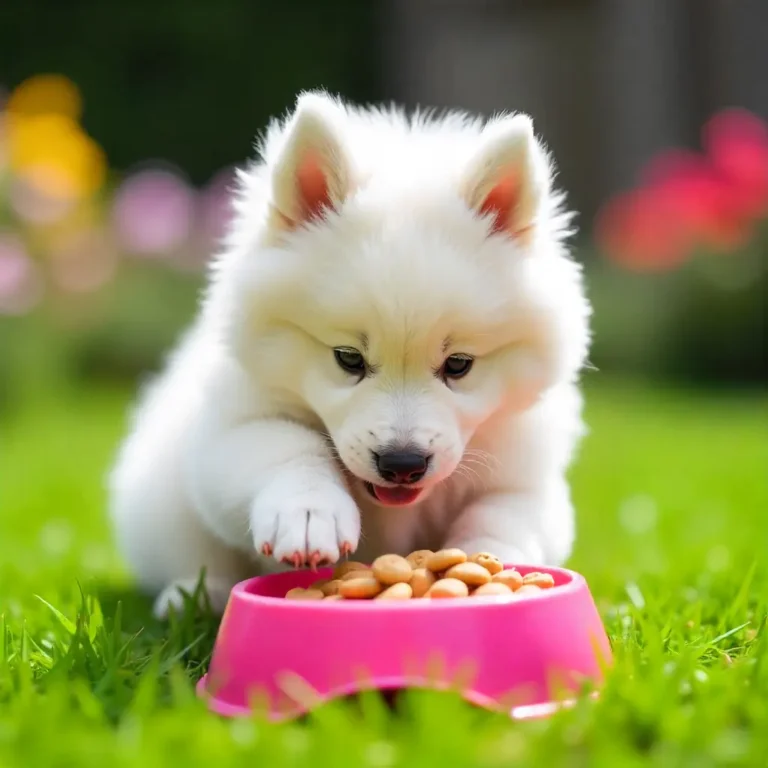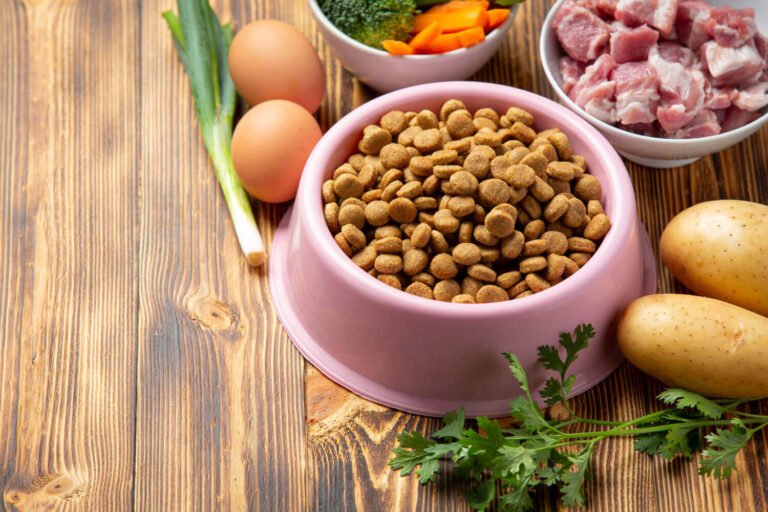How Often to Puppies Eat: The Big Misconception
Most new puppy parents think feeding a pup is simple—just put down a bowl whenever they look hungry.
But here’s the truth: puppies can’t regulate their meals like adult dogs. Overfeeding or underfeeding can actually harm their growth.
So, the real question isn’t just “what to feed puppies” but “how often to puppies eat for healthy growth?”
This isn’t about stuffing their bellies—it’s about giving them small, frequent meals that fuel their fast-growing bodies.
Key Point: Puppies need structure, not free-for-all snacking.
1.How Often to Puppies Eat by Age (Week-by-Week Guide)
Now let’s break it down by age because how often puppies eat changes as they grow. A 6-week-old pup can’t eat the same way as a 5-month-old.
6–12 Weeks Old Puppies: 4 Meals a Day
At this stage, puppies have tiny stomachs but big energy needs.
How often: 4 small meals a day
Why: Frequent meals keep blood sugar stable and prevent hypoglycemia.
Tip: Always go for puppy-formulated food with DHA and high protein.
3–6 Months Old Puppies: 3 Meals a Day
This is the “teething and growing” phase. Puppies are more active, but their digestion can handle slightly bigger meals now.
How often: 3 meals a day
Why: Supports growth spurts while starting to establish routine.
Tip: Use this stage to set good habits—avoid table scraps and stick to a balanced puppy feeding plan.
6–12 Months Old Puppies: 2 Meals a Day
This is where most puppies begin transitioning to an adult feeding routine.
How often: 2 meals a day
Why: Their metabolism is stabilizing, and portion control becomes crucial to prevent obesity.
Tip: Stick to measured portions instead of free feeding to avoid overeating.
Extra Note: Large breed puppies may need special feeding guidelines because they grow more slowly and are prone to joint problems. Always consult a vet for breed-specific advice.
2.How Much Should Puppies Eat by Size & Breed
A lot of puppy parents ask, “How much food should my puppy eat a day?”—but here’s the twist: there isn’t a one-size-fits-all answer.
Feeding a Chihuahua puppy the same way you’d feed a Great Dane puppy is a recipe for trouble.
Puppies need food amounts tailored to their size, breed, and growth rate.
Let’s break it down:
Small Breed Puppies (Chihuahuas, Yorkies, Pomeranians)
These little furballs have fast metabolisms and burn energy quickly.
How much to feed: ½ to 1 cup of high-quality puppy kibble daily, split into 3–4 meals.
Why: Their tiny stomachs can’t hold much at once, so frequent feeding keeps their energy up.
Tip: Small breed puppies are prone to low blood sugar, so don’t skip meals.
Medium Breed Puppies (Beagles, Cocker Spaniels, Bulldogs)
Medium breeds fall in the middle—not too delicate, not too giant.
How much to feed: 2–3 cups of balanced puppy food per day, split into 3 meals.
Why: They grow steadily but still need controlled portions to avoid puppy obesity.
Tip: Use a measuring cup—eyeballing food leads to overfeeding.
Large Breed Puppies (German Shepherds, Labradors, Golden Retrievers)
Large breeds are slow growers and have special needs.
How much to feed: 3–4 cups daily, divided into 2–3 meals.
Why: Overfeeding can make them grow too fast, leading to joint issues like hip dysplasia.
Tip: Always choose large-breed puppy food with the right calcium-phosphorus balance.
Giant Breed Puppies (Great Danes, Mastiffs, Saint Bernards)
These gentle giants take the longest to grow—sometimes up to 2 years!
How much to feed: 4–6 cups per day, spread across 3 meals while young, then taper to 2 meals.
Why: Growth must be slow and steady to prevent bone and joint issues.
Tip: Skip high-calorie foods; focus on controlled-energy formulas.
Quick Rule of Thumb:
Small breeds: 40 calories per pound of body weight
Medium breeds: 30–35 calories per pound
Large/Giant breeds: 20–25 calories per pound
3. How Much Should Puppies Eat by Weight
One of the biggest myths out there is that all puppies should eat the same amount just because they’re the same age.
Totally wrong.
The right portion depends more on your puppy’s weight and growth stage than on age alone.
If you’ve been wondering, “How much should I feed my 5 lb, 10 lb, or 20 lb puppy?” — here’s a simple breakdown.
Puppies Under 10 lbs
Think toy breeds and very young pups.
Daily food amount: ½ – 1 cup of puppy food, divided into 3–4 meals.
Why: Their tiny bellies fill up quickly but they burn calories fast.
Tip: Use high-quality small-bite kibble designed for toy breed puppies.
You can check our detailed guide on Dog Food Ingredients Explained (2025) to learn which nutrients really matter for growing toy pups.
Puppies 10–30 lbs
This range covers many popular breeds like Beagles, French Bulldogs, and Cocker Spaniels.
Daily food amount: 1 ½ – 2 ½ cups per day, divided into 3 meals.
Tip: At this stage, portion control is crucial — overweight puppies are at risk for lifelong joint problems.
Puppies 30–50 lbs
These include medium-to-large breeds like Labs and Collies.
Daily food amount: 2 ½ – 4 cups daily, split into 2–3 meals.
Why: Puppies in this range grow fast and need balanced calcium and protein for bone strength.
Not sure which food is safest for rapid-growing puppies? Our Best Dog Food 2025 Guide lists options by life stage and breed size.
Puppies Over 50 lbs
We’re talking future giants like Great Danes and Mastiffs.
Daily food amount: 4–6+ cups per day, usually split into 2 large meals (sometimes 3 while very young).
Tip: Don’t let them grow too fast — slow, steady growth keeps joints healthy.
Quick Chart: Puppy Feeding by Weight (Approximate)
| Puppy Weight | Daily Food Amount |
|---|---|
| 5 lbs | ½ – 1 cup |
| 15 lbs | 1 ½ – 2 cups |
| 30 lbs | 2 ½ – 3 ½ cups |
| 50 lbs | 4 – 5 cups |
| 70+ lbs | 5 – 6+ cups |
4. Puppy Feeding Schedule by Age
Knowing how much to feed is one part — but just as important is how often. Puppies can’t handle large meals in one sitting because of their tiny stomachs. That’s why a structured feeding schedule is key to healthy growth.
Here’s a simple age-based breakdown:
6–8 Weeks Old (Newly Weaned)
Meals per day: 4 meals (every ~4 hours)
Why: Their stomachs are very small and they need steady energy.
Food type: Choose a high-quality puppy formula, moistened with a little warm water if needed.
At this stage, free-feeding (leaving food out all day) is not ideal — puppies need structured meal times.
8–12 Weeks Old
Meals per day: 3–4 meals
Why: Puppies are rapidly growing and building muscle, bones, and immunity.
Tip: Consistency matters — feed around the same times daily (e.g., 7am, 12pm, 5pm, 9pm).
If your puppy has tummy issues, check out Special Diets for Dogs: Allergies, Sensitive Stomach, Grain-Free & More.
3–6 Months Old
Meals per day: 3 meals
Why: Growth rate is still high, but their stomach can handle more food at once.
Pro tip: Start adjusting portions using our Dog Food Calculator Tool to avoid overfeeding.
6–12 Months Old
Meals per day: 2 meals (morning + evening)
Why: By now, most breeds can transition to 2 meals like adult dogs.
Exception: Toy breeds may still need 3 small meals to prevent low blood sugar.
Quick Feeding Schedule Snapshot
| Puppy Age | Meals per Day |
|---|---|
| 6–8 weeks | 4 meals/day |
| 8–12 weeks | 3–4 meals/day |
| 3–6 months | 3 meals/day |
| 6–12 months | 2 meals/day |
5.Wet vs Dry Food for Puppies (and Mixing Both)
One of the biggest debates new puppy parents face is:
“Should I feed my puppy wet food, dry kibble, or both?”
A lot of people assume wet food is always “better” because it looks tastier or more natural. But the truth is — each has its pros and cons, and sometimes the best option is actually a mix.
Wet Food for Puppies
Pros:
High in moisture → great for hydration (especially if your puppy doesn’t drink much water).
Softer texture → easier for tiny teeth or weaning puppies.
Strong aroma → picky eaters usually love it.
Cons:
More expensive long-term.
Can cause softer stools if fed alone.
Doesn’t support teeth cleaning as well as kibble.
Dry Food (Kibble) for Puppies
Pros:
Convenient → easy to store and measure.
More affordable for daily feeding.
Crunchy texture helps reduce tartar buildup.
Cons:
Less palatable for picky eaters.
Lower moisture content (make sure water is always available).
6.Transitioning Puppy Food Safely (Avoiding Upset Stomach)
A lot of puppy parents make this mistake:
They switch foods overnight, thinking their pup will adjust right away.
Truth is, a sudden change in diet is one of the fastest ways to cause diarrhea, vomiting, or refusal to eat. Puppies have sensitive stomachs, and their gut bacteria need time to adapt to new food.
How to Transition Puppy Food Gradually
Follow the 7-Day Transition Rule recommended by vets:
| Days | Old Food | New Food |
|---|---|---|
| Day 1–2 | 75% | 25% |
| Day 3–4 | 50% | 50% |
| Day 5–6 | 25% | 75% |
| Day 7 | 0% | 100% |
Watch for Warning Signs
During the transition, monitor your pup for:
Loose stool or diarrhea
Vomiting
Loss of appetite
Excessive gas or bloating
If these signs persist beyond a couple of days → it’s time to pause and consult your vet before continuing.
When Do You Need to Transition
Puppy to adult food (usually around 12 months, or later for large breeds).
Switching brands (due to budget, allergies, or availability).
Vet-recommended diets (sensitive stomach, weight control, etc.).
Pro Tip
If your puppy is very sensitive, you can extend the transition to 10–14 days for an even gentler adjustment.
7. Common Feeding Mistakes Puppy Owners Make (and How to Avoid Them)
Most puppy parents mean well — but even with the best intentions, small feeding mistakes can lead to tummy troubles, poor growth, or picky eating habits. Don’t worry, I’ll walk you through the most common slip-ups and how to fix them.
Mistake 1: Free-Feeding All Day
Leaving food out 24/7 might sound convenient, but it often leads to:
Overeating → weight gain
Lack of routine → harder to potty train
Food boredom → picky eating later
Mistake 2: Giving Too Many Treats
It’s easy to spoil your pup with snacks, but treats should make up less than 10% of daily calories. Too many can:
Upset the tummy
Replace essential nutrients from real meals
Create bad begging habits
Pro Tip: Save treats for training rewards only.
Mistake 3: Sudden Food Changes
We covered this in detail earlier (see Transitioning Puppy Food Safely section discuss above), but it’s worth repeating: switching overnight = upset stomach. Always transition slowly.
Mistake 4: Feeding Table Scraps
Those puppy eyes are hard to resist — but many human foods are toxic to dogs (like onions, garlic, chocolate, and grapes). Even “safe” foods can:
Add empty calories
Create picky eaters
Cause long-term weight issues
See the ASPCA’s list of toxic foods for dogs for a quick reference.
Mistake 5: Ignoring Portion Control
Got Many owners overestimate how much food their puppy needs. Remember: feeding charts on dog food bags are just a starting point — every pup is different.
Mistake 6: Not Fresh Water with Meals
We get it—Google is quick and free. But when it comes to something as important as your dog’s food, a veterinarian-approved special diet for dogs is the safest route. Self-diagnosing your dog’s food allergies or tummy issues can lead to more harm than good.
Pro Tip: Always ask your vet before switching to limited ingredient diets, hydrolyzed protein formulas, or grain-free dog food. Some conditions mimic food sensitivities but need different treatment.
Conclusion:
Feeding a puppy isn’t just about filling a bowl — it’s about shaping their long-term health, growth, and happiness. By following a feeding schedule, choosing vet-approved puppy food, and avoiding common mistakes, you’re giving your pup the best possible foundation.
Remember: every puppy is unique. What works for one may not fit another, so keep an eye on your little buddy’s energy levels, growth, and body condition. And when in doubt, ask your vet — they’ll help tailor a feeding plan that fits your pup’s needs.
Over-Relying on Trendy Ingredients
Quinoa? Chickpeas? Kangaroo meat? Trendy ingredients can sound healthy (and exotic), but they aren’t always the best fit for your dog. Sometimes, simple, vet-formulated diets are far more effective than those that just look nutritious on the label.
Focus on: Nutritional balance, digestibility, and AAFCO-compliant recipes—not marketing buzzwords.
FAQs About How Often to Puppies Eat
How much food should I give my puppy each day?
It depends on age, breed, weight, and activity level. Most puppy food bags have a guideline.
How often should puppies eat?
Young puppies (8–12 weeks) usually need 4 meals per day. By 6 months, you can switch to 2–3 meals.
Can I feed my puppy human food?
Some foods like carrots, pumpkin, or blueberries are safe. But avoid onions, garlic, grapes, and chocolate.
What’s the difference between puppy food and adult dog food?
Puppy food has more protein, fat, and calories for growth. Adult food won’t meet their needs and can cause deficiencies if fed too early.
When should I switch my puppy to adult dog food?
Most puppies switch around 12 months, but large breeds may need puppy food until 18–24 months.
Do puppies need supplements?
Not usually. A high-quality commercial puppy food already has the right nutrients. Supplements should only be given if your vet recommends.
Why does my puppy always seem hungry?
Puppies have fast metabolisms, but constant hunger could mean:
They need larger portions
The food isn’t nutrient-dense
Or they may just be looking for attention
Can I feed my puppy raw food?
Some owners choose raw diets, but they come with safety risks (bacteria, imbalanced nutrition). Always consult your vet before trying raw feeding.
What treats can I give my puppy?
Opt for low-calorie training treats or safe fruits/veggies. Treats should make up no more than 10% of their daily calories.
How do I know if my puppy is overweight?
Check for a visible waistline and feel for ribs (without too much fat covering). If you can’t feel the ribs, your pup might be overweight.




